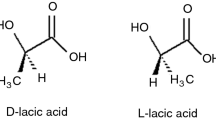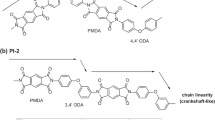Abstract
Two amphiphilic di-block copolymers with composition of PMMA118-b-PEO45 and PMMA25-b-PEO45 have been synthesized and characterized by NMR and FTIR spectroscopies. The critical micelle concentration (CMC) of synthesized copolymers in toluene has been determined. The variation in CMC of both polymers was recorded under the influence of temperature. Interestingly, it was found that CMC decreases with increase in the polymethyl methacrylate (PMMA) chain length and increase in temperature. A decrease in Gibbs free of micellization (ΔGmic) energy was found in the range of (− 17.3 to − 20.4), and increase in the entropy of micellization was observed in the range of (26.4 to 29.4) mol−1 at temperature in the range from 293 to 323 K with 10 K increment, while enthalpy is independent of temperature. From thermal analysis, it was concluded that degradation temperature slightly increases as the PMMA length increases. This is probably due to difficult diffusion of thermal energy across the entangled chains of PMMA.











Similar content being viewed by others
References
Hadjichristidis N, Stergios P, George F (2003) Block copolymers: synthetic strategies, physical properties, and applications. Wiley, Hoboken
Pizarro GD, Marambio OG, Henríquez CG, Vallejos MS, Geckeler KE (2013) Nanoreactors based on self-assembled amphiphilic diblock copolymers for the preparation of ZnO nanoparticles. Eur Polym J 49(11):3483–3491
Ma X, Li Y, Wang W, Ji Q, Xia Y (2013) Temperature-sensitive poly(nisopropylacrylamide)/graphene oxide nanocomposite hydrogels by in situ polymerization with improved swelling capability and mechanical behavior. Eur Polym J 49(2):389–396
Nawaz M, Baloch MK, Price GJ, Din I, El-Mossalamy ESEB (2013) Synthesis, association and surface morphology of poly(ethylene oxide)-polystyrene block copolymer. J Polym Res 20:180
Datta H, Bhowmick AK, Singha NK (2009) Methacrylate/acrylate ABA triblock copolymers by atom transfer radical polymerization; their properties and application as a mediator for organically dispersible gold nanoparticles. Polymer 50(14):3259–3268
Xiaojun W, Monojoy G, Rajeev K, Bobby G, Jimmy M (2012) Morphologies of block copolymers composed of charged and neutral blocks. Soft Matter 8:3036–3052
Xu J, Zhang Y, Zhang QA (2001) Novel approach to melt-processable molecular composites. Polymer 42(6):2689–2693
Yang X, Chen Y, Yuan R, Chen G, Blanco E, Gao J, Shuai X (2008) Folate-encoded and Fe3O4 loaded polymeric micelles for dual targeting of cancer cells. Polymer 49(16):3477–3485
Krishnamoorthy S, Pugin R, Pugin J, Heinzelmann H, Hoogerwerf AC, Hinderling C (2006) Block copolymer micelles as switchable templates for nanofabrication. Langmuir 22(8):3450–3452
Geng Y, Ahmed F, Bhasin N, Discher DE (2005) Visualizing worm micelle dynamics and phase transitions of a charged diblock copolymer in water. J Phys Chem B 109(9):3772–3779
Mark JE, Harry RA, Robert W (2005) Inorganic polymers. Oxford University Press, London
Zhang Y, Zhang Q, Cheng K, Xu J (2004) A novel method for the preparation of monocarboxyl end-grouped polycaprolactam with an adjustable molecular weight. Appl Polym Sci 92(2):722–727
Jungki K, Michelle MM, Robert WS, Dong JW, John MT (2006) Uniquely broad glass transition temperatures of gradient copolymers relative to random and block copolymers containing repulsive comonomers. Macromolecules 39(18):6152–6160
Choucair A, Eisenberg A (2003) Interfacial solubilization of model amphiphilic molecules in block copolymer micelles. J Ameri Chem Soci 125(39):1993–2000
Varshosaz J, Hassanzadeh F, Sadeghi-Aliabadi H, Larian Z, Rostami M (2014) Synthesis of pluronic F127-poly(methyl vinyl ether-alt-maleic acid) copolymer and production of its micelles for doxorubicin delivery in breast cancer. Chem Eng J 240:133–146
Suzuki T, Murakami Y, Takegami Y (1980) Synthesis and characterization of block copolymers of poly(ethylene oxide) and poly(methyl methacrylate). Polym J 12:183–192
Hasegawa T (2017) Quantitative infrared spectroscopy for understanding of a condensed matter. Springer, Tokyo
Schachtschneider JH, Snyder RG (1963) Vibrational analysis of the n-paraffins-II: normal co-ordinate calculations. Spectrochim Acta 19:117–168
Vacatello M, Flory PJ (1986) Conformational statistics of poly(methyl methacrylate). Macromolecules 19:405–415
Gao Z, Varshney SK, Wong S, Eisenberg A (1994) Block copolymer crew-cut micelles in water. Macromolecules 27(26):7923
Kwon GS, Okano T (1996) Polymeric micelles as new drug carriers. Adv Drug Deliv Rev 21(2):107–116
Yuan J, Shi Y, Fu Z, Yang W (2006) Synthesis of amphiphilic poly(methyl methacrylate)-block-poly(methacrylic acid) diblock copolymers by atom transfer radical polymerization. Polym inter 55(3):360
Oikonomou EK, Pefkianakis EK, Bokias G, Kallitsis JK (2008) Direct synthesis of amphiphilic block copolymers, consisting of poly(methyl methacrylate) and poly(sodium styrene sulfonate) blocks through atom transfer radical polymerization. Eur Polym J 44(6):1857–1864
Lin CH, Tung YC, Ruokolainen J, Mezzenga R, Chen WC (2008) Poly[2,7-(9,9-dihexylfluorene)]-block-poly(2-vinylpyridine) rod−coil and coil–rod–coil block copolymers: synthesis, morphology and photophysical properties in methanol/THF mixed solvents. Macromolecules 41(22):8759–8769
Pramoda KP, Liu S, Chung TS (2002) Thermal imidization of the precursor of a liquid crystalline polyimide. Macromol Mater Eng 287(12):931
Samia AK, Laila M, Al-Harbi LM, Baloch MK, Ullah I, El-Mossalamy EH (2016) Impact of block length and temperature over self-assembling behavior of block copolymers. Int J Polym Sci 2016:1–7
Zushun X, Lianzian F, Jian J, Shiyuan C, Yongchun C, Changfeng Y (2013) The micellization of amphiphilic graft copolymer PMMA-g-PEO in toluene. Eur Polym J 34(10):1499–1504
Burke SE, Eisenberg A (2001) Effect of sodium dodecyl sulfate on the morphology of polystyrene-b-poly(acrylic acid) aggregates in dioxane-water mixtures. Langmuir 17(26):8341–8347
Discher BM, Won YY, Ege DS, Lee JC, Bates FS, Discher DE, Hammer DA (1999) Polymersomes: tough vesicles made from diblock copolymers. Science 284(5417):1143
Jenekhe SA, Chen XL (1999) Self-assembly of ordered microporous materials from rod–coil block copolymers. Science 283(5400):372–375
Maria K, Stergios P (2016) Fluorescence studies of polymer containing systems. Springer, pp 27–63
Chen HW, Liang Y, Yu M, Chen L (2009) Synthesis of poly(methyl methacrylate) via reverse atom transfer radical polymerization catalyzed by FeCl3/lactic acid. J Appl Polym Sci 114(3):1593–1597
Valentina G, Diego A, Katia S, Michele L, Tommaso JG, Federico FL, Gabriele S, Michele P (2013) On the thermal stability of PS-b-PMMA block and P(S-r-MMA) random copolymers for nanopatterning applications. Macromolecules 46(20):8224–8234
Holland BJ, Hay JN (2002) The effect of polymerisation conditions on the kinetics and mechanisms of thermal degradation of PMMA. Polym Degrad Stab 77(3):435–439
Crystal EP, Frank DB (2000) Thermal characterization of PMMA thin films using modulated differential scanning calorimetry. Macromolecules 33(19):7016–7020
Xue L, Agarwal US, Lemstra PJ (2002) High molecular weight PMMA by ATRP. Macromolecules 35:8650–8652
Acknowledgements
The authors are thankful to the Higher Education Commission of Pakistan for providing financial support.
Author information
Authors and Affiliations
Corresponding authors
Additional information
Publisher's Note
Springer Nature remains neutral with regard to jurisdictional claims in published maps and institutional affiliations.
Rights and permissions
About this article
Cite this article
Imad-Ud-Din, Rehman, Z.U., Nawaz, M. et al. Self-assembly and thermal behavior of amphiphilic di-block copolymers of poly(methyl methacrylate)-block-poly(ethylene oxide) (PMMA-b-PEO). Polym. Bull. 80, 1845–1859 (2023). https://doi.org/10.1007/s00289-022-04148-8
Received:
Revised:
Accepted:
Published:
Issue Date:
DOI: https://doi.org/10.1007/s00289-022-04148-8




